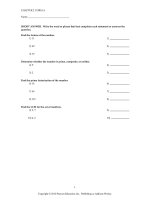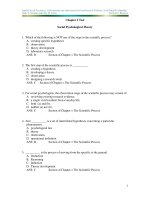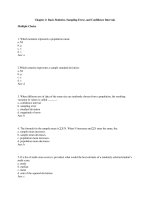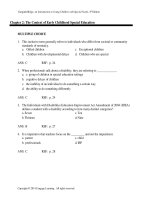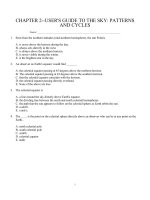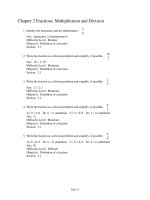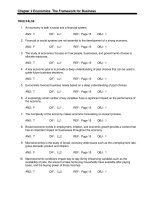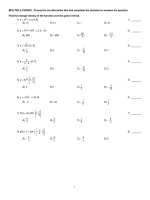Applied statistics from bivariate through multivariate techniques 2nd edition warner test bank
Bạn đang xem bản rút gọn của tài liệu. Xem và tải ngay bản đầy đủ của tài liệu tại đây (123.4 KB, 5 trang )
Chapter 2: Basic Statistics, Sampling Error, and Confidence Intervals
Multiple Choice
1. Which notation represents a population mean:
a. M
b. µ
c. z
d. s
Ans: a
2.Which notation represents a sample standard deviation:
a. M
b. µ
c. z
d. s
Ans: d
3. When different sets of data of the same size are randomly chosen from a population, the resulting
variation in values is called ______.:
a. confidence interval
b. sampling error
c. standard deviation
d. magnitude of error
Ans: b
4. The formula for the sample mean is ∑X/N. When N increases and ∑X stays the same, the:
a. sample mean increases.
b. sample mean decreases.
c. population mean increases.
d. population mean decreases.
Ans: b
5. If a list of math exam scores is provided, what would the best estimate of a randomly selected student’s
math score:
a. mode
b. median
c. mean
d. sum of the squared deviations
Ans: c
6. The inclusion of an extreme outlier will affect which statistic the most:
a. mode
b. median
c. mean
d. sum of the squared deviations
Ans: c
7. The mean, median, and mode are the same value for what type of distribution:
a. skewed
b. normal
c. uniform
d. triangular
Ans: b
8. What is the minimum value for the sum of the squared deviations:
a. -∞
b. -1
c. 0
d. ∞
Ans: c
9. The statistic calculated by summing the deviations, squaring the result, and then dividing by the sample
size minus one is the sample:
a. standard deviation
b. variance
c. mean
d. median
Ans:b
10. The proportion of the area of a normal distribution greater than 12.1% is z=____. Use Appendix A of
your textbook:
a. 0.30
b. 0.97
c. 1.17
d. 2.25
Ans: c
11. As N increases, the standard error of the mean:
a. increases
b. decreases
c. remains constant
d. varies randomly
Ans: b
12. As the standard deviation decreases, the standard error of mean:
a. increases
b. decreases
c. remains constant
d. varies randomly
Ans: b
13. The difference between the population mean and the sample mean is called the:
a. estimation error
b. standard error
c. magnitude of the difference
d. prediction error
Ans: a
14. At what degrees of freedom is a t distribution similar to a normal distribution:
a. 25
b. 50
c. 75
d. 100
Ans: d
15. Which of the following statistics is not used in the calculation of a confidence interval:
a. population mean
b. standard error
c. critical value
d. sample mean
Ans: d
True/False
1. The degrees of freedom for a statistic provides the number of independent pieces of information.
Ans: True
2. Dividing the sum of squares by the sample size overestimates the population variance.
Ans: False
3. Usually, we know the population mean and population standard deviation for a given data set.
Ans: False
4. As the degrees of freedom for the t distribution increases, the shape of the distribution becomes
leptokurtic.
Ans: True
5. The definition of a confidence interval is a 95% chance of including the population parameter between
the upper and lower limits.
Ans: False
Short Answer
1. Calculate the sample mean for the following values of systolic blood pressure: 130, 152, 120, 107, 110,
143.
Ans: 127.00
2. Calculate the sample standard deviation for the following values of systolic blood pressure: 130, 152,
120, 107, 110, 143.
Ans: 18.04
3. Compute the sample standard error of the mean for the following values of systolic blood pressure:
130, 152, 120, 107, 110, 143.
Ans: 7.37
4. Calculate the 95% confidence interval of the mean for the following values of systolic blood pressure:
130, 152, 120, 107, 110, 143.
Ans: [108.06, 145.94]
5. Which scores are used to determine the proportion of subjects whose test scores lie between –X and
+X?
Ans: z scores
Essay
1. Contrast the standard deviation and the standard error.
Ans: SD shows the variation around a single measurement of the mean. SE shows the variation around
the average of repeated measurements of the mean.
2. What is the meaning of a confidence interval?
Ans: Whether in a sample or a population, the CI is a range of values above and below a sampl statistic
that is likely to include that statistic. For example, in a 95% CI, if hundreds of intervals were constructed
from random sampling, we would expect that 95% of the CI’s would contain the sample statistic.

